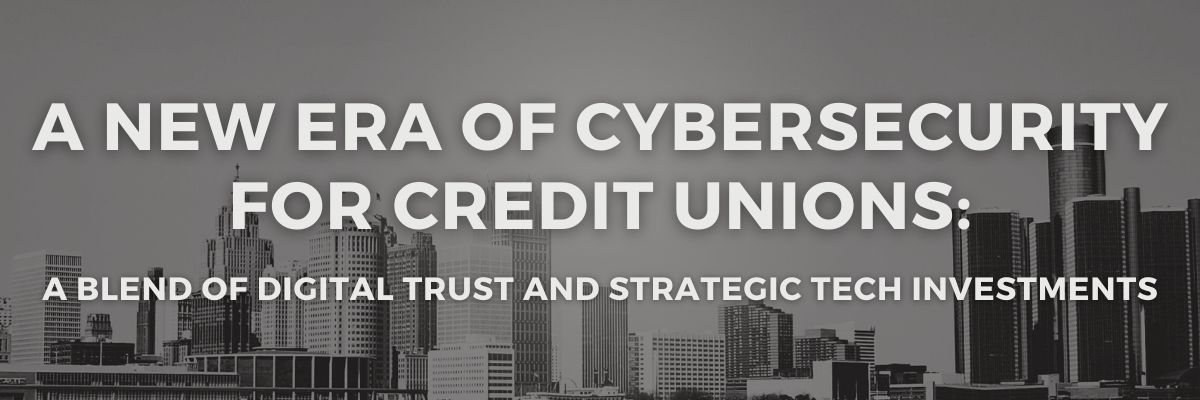
Within a dynamic digital landscape, credit unions face numerous challenges in safeguarding member information and maintaining a strong security posture. These challenges include a growing number of phishing attacks and data breaches. Meanwhile, the fraudsters remain relentless, discovering new ways to infiltrate vulnerable systems.
Consider these insights from MDT’s cybersecurity expert and Chief Technology Digital Officer, Matt Baaki, sharing his view on establishing digital trust and the right cybersecurity investments.
Redefining Modern Cybersecurity:
It begins by transitioning our focus from traditional data security to fostering digital trust. Baaki describes this trust as confidence in a credit union’s technologies and processes while prioritizing the security of its overall digital environment: “Digital trust encompasses privacy, cybersecurity, compliance, reliability, and ethical data practices. It also necessitates a holistic view of all systems in alignment with industry-centric digital trust guidelines,” says Baaki. “This comprehensive strategy ensures a secure digital experience and instills member confidence.”
He notes that recent months have seen a surge in vendor breaches and phishing attacks, posing significant risks to credit unions and their members.
As Baaki points out, vendor due diligence is critical to fraud prevention, particularly with the rise in ransomware attacks leading to these data breaches. “There will always be risks, but regularly reviewing vendor contracts and their security safeguards — and implementing tools that alert credit unions about vendor issues — can prevent infiltration.”
There’s also been an uptick in email phishing attacks that bypass traditional security measures — and these can expose weakness if there is a lack of safeguards on the vendor side. “Compromised vendor email accounts, for example, can lead to a well-crafted phishing attack on a credit union,” Baaki explains. “These threat actors typically bypass multifactor authentication to access a recipient’s data, making it crucial for everyone in the organization to be cautious and not implicitly trust emails.”
Comprehensive email security capabilities can safeguard against malicious threats and block harmful domains. This ability to monitor and respond to such threats effectively — and in real-time is critical.
Threat detection also requires developing a credit union’s in-house expertise —or collaborating with specialized XDR (Extended Detection and Response) vendors. For instance, an XDR vendor can create sophisticated detection signatures crucial in handling active incidents.
A broader view of IT security is essential. It also requires due diligence when evaluating a vendor’s contract and capabilities.
Setting Clear Expectations
Communication is critical to establishing digital trust, requiring increased visibility at the board and executive levels. It also means engaging stakeholders in cybersecurity and policy discussions. Baaki suggests setting formal, consistent security training to raise awareness and bolster a credit union’s security posture. “Educating stakeholders on how fraudsters operate while keeping team members on the same page can’t be stressed enough,” he adds.
Also, consider hiring a consultant if help is needed in policy review. An objective viewpoint offers immeasurable benefits and can ensure compliance with your credit union.
Security awareness for all stakeholders while implementing training at all levels is a must.
Crafting the Right ‘Playbook’
Attacks will continue to transpire, and Baaki recommends creating detailed incident response forms that outline stakeholder responsibilities and appropriate responses when incidents occur. Ideally, a response form will contain factors such as Preparation, Detection and Analysis, Containment, Eradication, and Recovery, Post- Incident Activity, Incident Handling Checklist, and Recommendations.
“MDT uses daily Threat and Fraud Intelligence Reporting (TFIR) to provide reports of ongoing threats, including a digestible summary of the activity,” says Baaki. “We call these reports ‘playbooks,’ vital to ongoing client communication and strengthening fraud defense. They enable everyone in the organization to understand their roles and necessary response objectives clearly.”
Response forms also allow credit unions to manage their actions with autonomy, encouraging greater success. “Treat incidents aggressively, and don’t delay your response,” stresses Baaki. “When action is taken quickly, in real-time, you mitigate risk, and threats can be managed efficiently and effectively.”
Talent and Tech Tools
Building a security framework requires developing and retaining in-house talent and choosing the right tech tools. In Baaki’s recent article, “Factors to Consider When Planning Your Next Cybersecurity Tech Investment,” he explains these sometimes conflicting priorities:
- Talent Retention: Consider strategies that preserve and enhance your IT team’s skills and internal career prospects.
- Tech Tools: Consider a SIEM (Security Information and Event Management) solution within a managed SOC (Security Operations Center). It’s a cost-effective way to identify threats and simplify cybersecurity protocols proactively.
- Selection Criterion: When selecting a managed SIEM solution, ensure it matches available resources and your team’s skillset. Solutions should also bolster cybersecurity, offer compliance support, and meet cyber insurance requirements.
- Clear Workflows: Solutions should offer transparent workflows and alert prioritizations, especially relevant for smaller teams. Choose modern, cloud-based solutions for quick implementation and to realize immediate value whenever possible.
- Resource Allocation: The resources a credit union allocates to security must be carefully measured. It takes evaluation of a cybersecurity platform, including budgetary concerns, implementation time, usability, and measurability.
Preserving IT talent while managing costs is integral to success. SIEM and SOC solutions can help bolster systems and processes cost-effectively.
Final Thoughts
Adopting a broader, holistic approach to cybersecurity is the framework for success, requiring a shift from IT security to a posture of building digital trust. It demands proactive measures against evolving threats and ensuring that tech investments align with an organization’s resources and needs. Focusing on these aspects, credit unions can protect their members’ data while building trust in a digital world fraught with risk.
Knowing that you don’t have to go it alone when building digital trust is reassuring. Turn to the experts at MDT for innovative solutions and the expertise you need. Contact MDT at mdtmi.com/contact to learn more.




